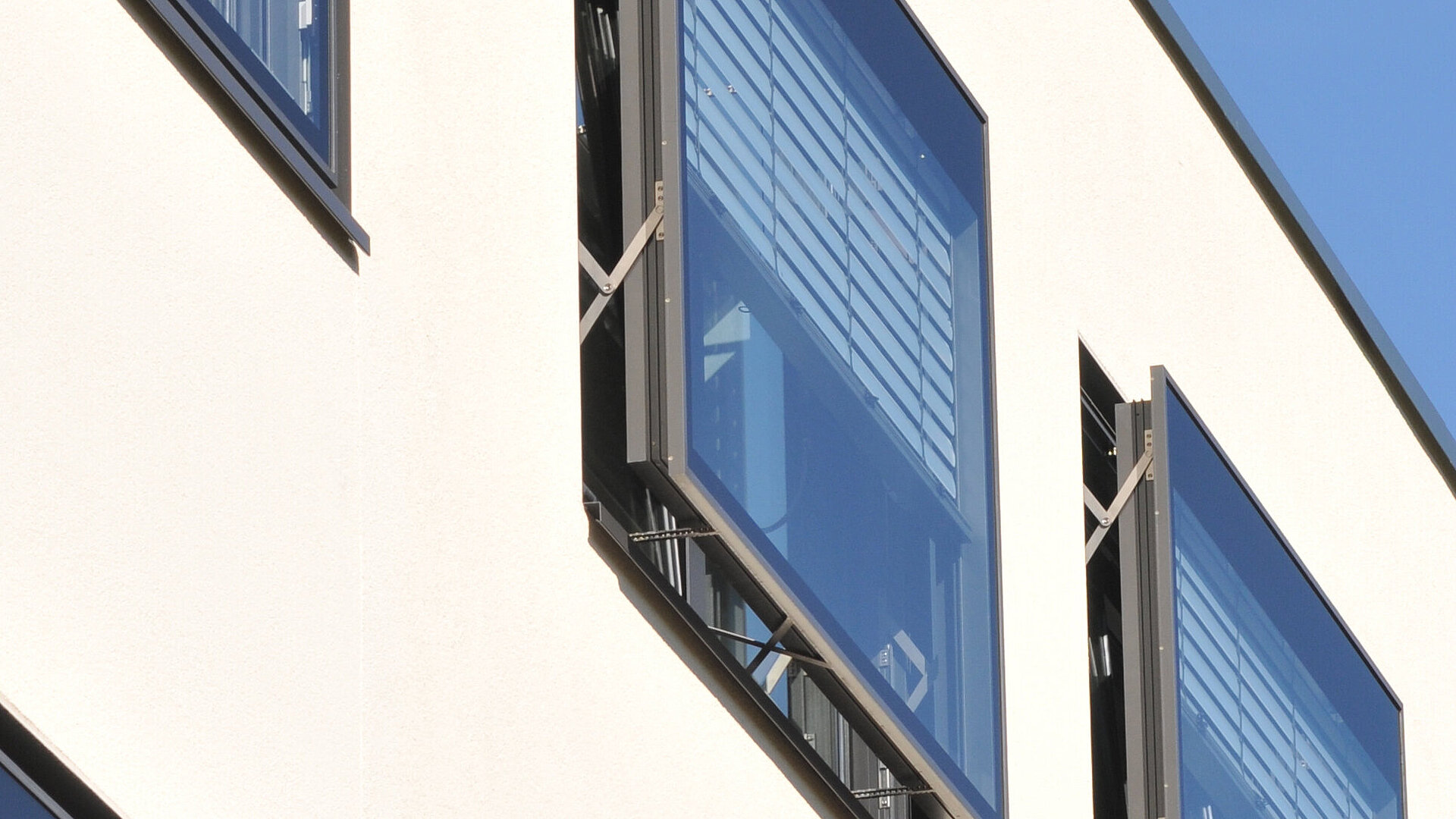Reading time: 1 minute
The Energy Performance of Buildings Directive (EBPD) 2010 of the EU for new construc-tions until end 2018 requires the lowest energy performance of buildings standard (nearly zero energy buildings), which is being implemented nationally by the more stringent re-quirements of the Energy Saving Regulations (EnEV) of 2016.
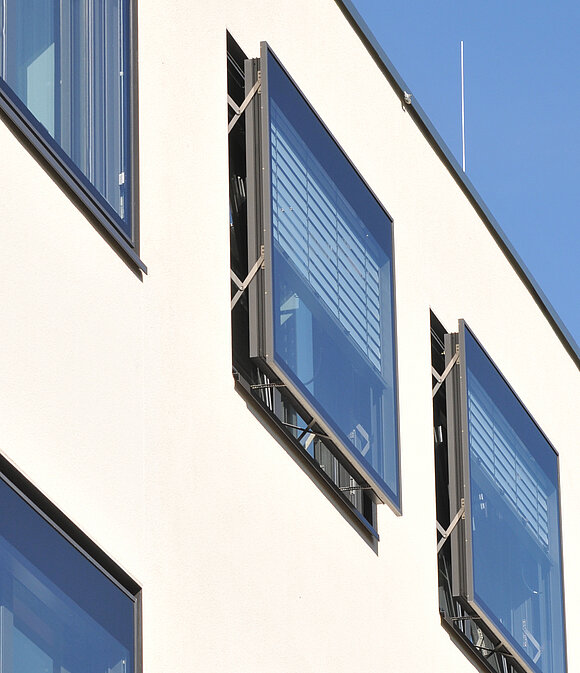
Coupled windows are an optimal option for meeting the more stringent requirements for heat protection in summer and thermal insulation in winter equally. Coupled windows consist of two casement frames with an air space between in which the solar shading can be integrated such that it is protected against weather. The advantage compared to fittings in the inter-pane cavity is that you can separate the two sashes easily in order to clean, maintain or replace the solar shading and anti-glare elements. Moreover, you can also integrate systems for regenerative energy utilisation, e.g. photovoltaic elements. Coupled windows are suitable for maintaining historical urban patterns since the inner sash meets the requirements for heat and sound insulation and the outer sash can be executed according to design specifications. This is why the majority of system providers offer coupled windows and they are a good opportunity for metal builders to offer high-performance systems including solar/glare protection for high-quality public buildings or commercial properties.
However, there may be condensation forming in the space between the two sashes that is perceived by the building owners as a defect and often leads to complaints and legal confrontations. The following contribution illustrates the correlations at the building physics level as well as construction-related solutions for the same.
The "natural" building physics of condensation
Condensate formation is a natural phenomenon of building physics that is influenced by the weather conditions, solar shading, incoming flow, occurrence of moisture, cleaning, air conditioning of the rooms, orientation, building height as well as naturally by the window construction. Everyone is aware of condensate on car window panes or as frost with plants. This is caused by the cooling down of the surface below the dew point temperature, which occurs as a result of the large temperature difference in case of a clear and cold night sky between universe and the surfaces near the ground. In this way, the glass surfaces also get cooled down below the ambient atmospheric temperature. If the dew point temperature gets undershot in the process, dew precipitates on the surface. Flat car window panes "see" plenty of sky and cool down quite considerably – the same is true of the roof window. Vertical glass panes are not affected so considerably, but nonetheless, with highly thermally insulating constructions, there may be condensate, and in fact, ice forming on the outside of the outer glass pane. Condensate within the space of coupled windows occurs when the air exchange with the outdoor air takes place gradually, especially in combination with double or triple glazing.
In the context of the standard, condensed water as such is not a defect, since DIN 4108-2 [3] describes the following in Section 6.1: "Condensate formation is permissible temporarily and in small quantities on windows as well as stick constructions, if the surface does not absorb the moisture and appropriate precautions are taken to prevent contact with neighbouring sensitive materials."
Temporary condensate (e.g. frost formation in the morning), but even longer occurrence as a consequence of unfavourable outdoor climate (e.g. still air, high atmospheric humidity, no solar radiation") must be accepted provided that the concerned surfaces and materials are insensitive to moisture, for example, with metal profiles. However, this is not necessarily true for adjacent wall superstructures with insulating or wooden materials.
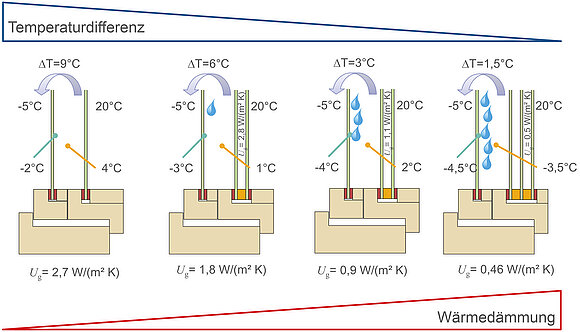
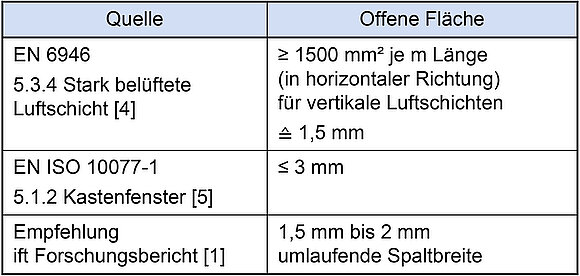
of the space between the two sashes
Principles of construction for reducing the risk of condensate
The critical season for coupled windows is the transition period when atmospheric humidity and temperature of the outdoor climate is subject to relatively quick change. In this case, condensed water within the construction cannot be avoided. However, it can be minimised with the help of constructive measures, which enable the necessary vapour pressure equalisation from the gap in the sash to the outdoor climate. The equalisation always takes place from the location of the higher vapour pressure to that of the lower and thus, generally to the outside.
The simplest opening is that gap on all four sides between both sashes on the outer structural rebate. Recommendations for ventilation of the space between the two sashes are compared in Table 1. DIN EN 6946 specifies a converted gap of ≥ 1.5 mm on all four sides for ventilated air layers. In the calculation standard EN ISO 10077-1, the gap on all four sides is limited to ≤ 3 mm in order to avoid unnecessary air exchange with the outdoor air that degrades the thermal insulation.
In case of integrated sunshade elements, the space between the two sashes gets heated up by absorption of the solar radiation. The heat must get dissipated outside so that the total solar energy transmitted (g value) does not deteriorate with high surface temperatures on the room side and the metal windows do not expand considerably, get deformed and cause damage. If necessary, larger surface areas are necessary here. The function and fitness for use of the construction can be checked easily by a calorimetric measurement, in which all energy and heat flows are recorded and even the surface temperatures can be measured at any point.
A gap on all four sides is difficult to implement if additional requirements such as enhanced sound insulation are specified for the building component. The gap can be replaced with offset drilling holes or with a labyrinth between the space and the outdoor air. However, this leads to the fact that the construction rules for the necessary opening face of a joint on all four sides cannot be applied. The functionality of the vapour pressure equalisation system can be checked only by testing the dew point performance by measuring the temperatures and determining the partial vapour pressures.
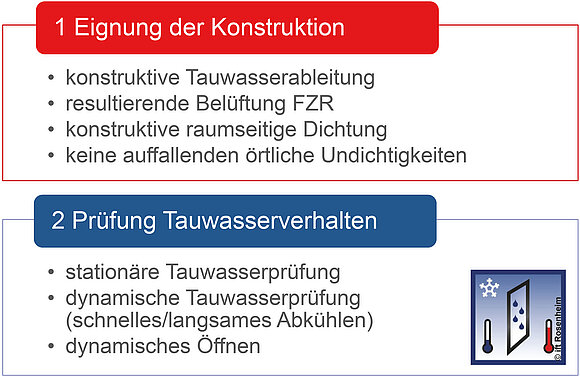
and double windows
The connection to the room side, in contrast, must necessarily be avoided. In order to ensure functional sealing on the room side, concealed hardware that does not interrupt the sealing level is well suited. Even the most minor leakages lead to failure of the construction; hence, the function of the seal must be checked at the time of production and assembly. Test equipment for determining the air permeability according to EN 1026 is appropriate for this purpose.
Measurement is done with a climatic test rig using the 2-chamber principle, in which the function of the vapour pressure equalisation system is verified. By measuring the values of air temperature and humidity in the space between the two sashes, the partial pressures of water vapour can be determined. You can assume formation of condensed water as soon as the dew point temperature has been undershot. This is also identified and documented with visual assessment.
Literature
- Böttcher, W.; Hartmann, H.-J.; Schmid, J.
Untersuchung an Verbundfenstern zur Verbesserung des Wärme- und Schallschutzes bei gleichzeitiger Sicherstellung der übrigen Funktionen, wie Tauwasser usw..
Research report of ift Rosenheim, July 1981 - ift Hausverfahren (WÄR11)
Prüfung des Tauwasserverhaltens von Elementen (Testing the dew point performance of elements)
ift Rosenheim, 2016 - DIN 4108-2:2013-02
Thermal protection and energy economy in buildings - Part 2: Minimum requirements to thermal insulation
Beuth Verlag GmbH - DIN EN ISO 6946:2008-04
Building components and building elements - Thermal resistance and thermal transmittance - Calculation method.
Beuth Verlag GmbH, Berlin - DIN EN ISO 10077-1:2010-05
Thermal performance of windows, doors and shutters - Calculation of thermal transmittance - Part 1: General.
Beuth Verlag GmbH, Berlin
